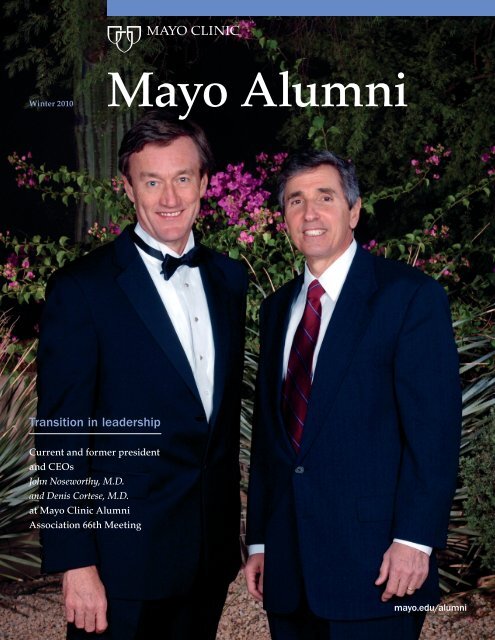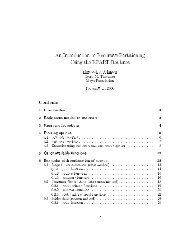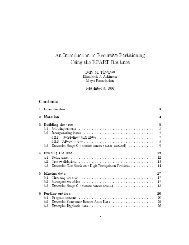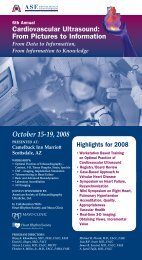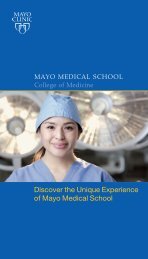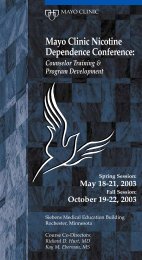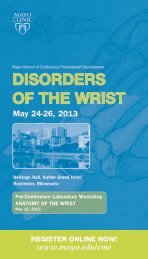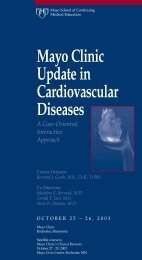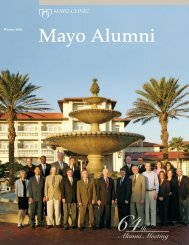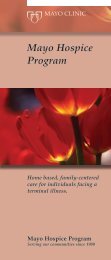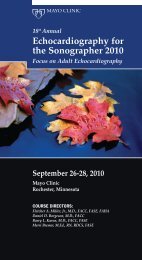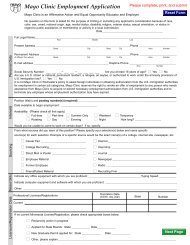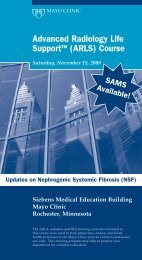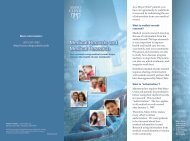Humanitarian Award - Mayo Clinic
Humanitarian Award - Mayo Clinic
Humanitarian Award - Mayo Clinic
You also want an ePaper? Increase the reach of your titles
YUMPU automatically turns print PDFs into web optimized ePapers that Google loves.
Winter 2010 <strong>Mayo</strong><br />
Transition in leadership<br />
Current and former president<br />
and CEOs<br />
John Noseworthy, M.D.<br />
and Denis Cortese, M.D.<br />
at <strong>Mayo</strong> <strong>Clinic</strong> Alumni<br />
Association 66th Meeting<br />
Alumni<br />
mayo.edu/alumni
<strong>Mayo</strong> Alumni<br />
Winter 2010<br />
From left, Denis Cortese, M.D.,<br />
former president and CEO;<br />
Shirley Weis, chief administrative<br />
officer; Glenn Forbes, M.D.,<br />
former Rochester CEO;<br />
John Noseworthy, M.D.,<br />
president and CEO.<br />
The Doctors <strong>Mayo</strong> Society<br />
Did you know … ?<br />
• Alumni younger than 40 can<br />
join The Doctors <strong>Mayo</strong> Society<br />
by committing to annual gifts<br />
of $500 toward a total pledge<br />
of $10,000.<br />
• Alumni 40 and older can join<br />
The Doctors <strong>Mayo</strong> Society with<br />
gifts and pledges totaling $10,000<br />
or more over 10 years.<br />
• <strong>Mayo</strong> Alumni Laureates<br />
recognizes alumni who make a<br />
gift, pledge or irrevocable estate<br />
gift of $100,000 or more.<br />
See page 15 for more information on<br />
the Doctors <strong>Mayo</strong> Society<br />
Features<br />
2 <strong>Mayo</strong> <strong>Clinic</strong> Alumni Association 66th Meeting<br />
Profile of new Alumni Association president Dr. S. Mark Laney<br />
Opening remarks from MCAA and <strong>Mayo</strong> <strong>Clinic</strong> leaders<br />
Speakers — Dr. John Hardman, Dr. Robert Kyle, Dr. Denis Cortese<br />
<strong>Award</strong> recipient profiles — Dr. William Manger, Dr. John Woods,<br />
Dr. Nicholas LaRusso, Dr. Edward Rosenow III, Dr. Travis McKenzie,<br />
Dr. Rory Smoot, Dr. C. Daniel Smith<br />
15 Successful conclusion to The Campaign for <strong>Mayo</strong> <strong>Clinic</strong><br />
16 Dr. Denis Cortese’s leadership contributions<br />
20 A conversation with Dr. John Noseworthy,<br />
new <strong>Mayo</strong> <strong>Clinic</strong> president and CEO<br />
23 What’s ahead for Health Policy Center<br />
<strong>Mayo</strong> Update<br />
24 Obituaries<br />
A Letter from the President<br />
Outgoing president and CEO Dr. Denis Cortese established<br />
a road map for the future and helped make words like<br />
transformation, health care delivery and individualized<br />
medicine part of everyday language at <strong>Mayo</strong> <strong>Clinic</strong>. Those<br />
concepts and many more were front and center at the 66th<br />
meeting of the <strong>Mayo</strong> <strong>Clinic</strong> Alumni Association in Scottsdale, Ariz. Both Dr. Cortese<br />
and his successor, Dr. John Noseworthy, attended the meeting. A transition in<br />
leadership is a time for reflection and thanks as well as interest and anticipation.<br />
This issue of <strong>Mayo</strong> Alumni includes a retrospective of Dr. Cortese’s contributions<br />
and an interview with Dr. Noseworthy.<br />
Thank you to all who attended the 66th meeting. It was a wonderful opportunity<br />
to connect with friends and colleagues and be immersed in medical and scientific<br />
updates. I am grateful to my friend Dr. David Teegarden for the smooth transition of<br />
leadership in the presidency of the <strong>Mayo</strong> <strong>Clinic</strong> Alumni Association. I look forward<br />
to the honor of serving you.<br />
S. Mark Laney, M.D.<br />
President, <strong>Mayo</strong> <strong>Clinic</strong> Alumni Association
Dr. Laney at the 66th<br />
Alumni Association<br />
meeting (top) and with<br />
family (above) — wife,<br />
Mary Margaret, daughter,<br />
Jordan, and twin brother,<br />
Jim, a college professor at<br />
the University of North<br />
Texas in Denton.<br />
S. Mark Laney, M.D. (PDN ’89), the new president of the <strong>Mayo</strong><br />
<strong>Clinic</strong> Alumni Association, has much in common with his friend<br />
David Teegarden, M.D., the immediate past president. Both are native<br />
Texans who trained at <strong>Mayo</strong> <strong>Clinic</strong> and returned to practice in the<br />
Lone Star State. Both received master’s degrees in medical management from the<br />
University of Texas at Dallas, and became involved in leadership roles at health<br />
systems. Both have served on the Alumni Association’s board of directors. And<br />
both were influenced by a favorite childhood physician. In Dr. Teegarden’s case,<br />
watching his family physician inspired his career choice. Dr. Laney’s inspiration<br />
came from his maternal uncle, Kenneth Matthews, M.D.<br />
“From the time I was in elementary school, I thought I’d be a small town<br />
pediatrician,” says Dr. Laney. “In high school, I followed my uncle during school<br />
breaks. He loved his work and gave back to his community, and that was an<br />
irresistible combination to me.”<br />
After his pediatric training, Dr. Laney sought a fellowship in pediatric neurology.<br />
“<strong>Mayo</strong> <strong>Clinic</strong> neurology was top-ranked for many years, so I applied there and was<br />
offered a position,” he says. “I couldn’t pass up the adventure of living in a different<br />
part of the country, working in a neurology department with an international<br />
reputation. The cold weather was fun for this Texan, and the teaching and mentoring<br />
were second to none.<br />
“<strong>Mayo</strong> had a huge, lasting effect on me. I learned to practice team medicine and<br />
the advantages of a multispecialty group practice. I learned the importance of<br />
physician leadership in medicine and why the needs of the patient should come first.<br />
“<strong>Mayo</strong>-trained physicians have influenced the practice of medicine and<br />
replicated the <strong>Mayo</strong> model of care around the world. I’ve applied the <strong>Mayo</strong> principles<br />
in building and maturing the practices I’ve been involved with.”<br />
Dr. Laney says he is honored<br />
S. Mark Laney, M.D.<br />
President and CEO, Heartland Health, St. Joseph, Mo.<br />
New <strong>Mayo</strong> <strong>Clinic</strong> Alumni<br />
Association president<br />
Another Texan at the helm<br />
Fellowship: <strong>Mayo</strong> School of Graduate Medical Education<br />
Residency: Arkansas Children’s Hospital, University of<br />
Arkansas for Medical Sciences<br />
Medical school: University of Texas Medical Branch, Galveston<br />
Undergraduate: University of North Texas, Denton<br />
Native of: Denton, Texas<br />
Family: Wife, Mary Margaret; daughter, Jordan<br />
to give back to <strong>Mayo</strong> <strong>Clinic</strong><br />
via leadership of the Alumni<br />
Association. “<strong>Mayo</strong> is a national<br />
treasure, and it has invested time<br />
in me,” he says. “Everyone who<br />
trained at <strong>Mayo</strong> takes a bit of it<br />
wherever they go. The values the<br />
brothers <strong>Mayo</strong> built the clinic on<br />
are alive and well around the<br />
world, through <strong>Mayo</strong> alumni.<br />
What a wonderful story.”<br />
Winter 2010 1
Exploring<br />
New<br />
Frontiers<br />
A <strong>Mayo</strong> Tradition<br />
MAyo CLINIC<br />
ALUMNI ASSoCIATIoN<br />
66TH MEETINg<br />
2 <strong>Mayo</strong> Alumni<br />
october<br />
2009<br />
T<br />
he biennial meeting of the <strong>Mayo</strong><br />
<strong>Clinic</strong> Alumni Association —<br />
a tradition dating back to 1917 —<br />
conducts the business of the organization<br />
and brings alumni from around<br />
the world back to a <strong>Mayo</strong> <strong>Clinic</strong><br />
location. The 2009 meeting assembled<br />
almost 500 alumni and their guests<br />
from 28 U.S. states, the District of<br />
Columbia and five other nations.<br />
In convening, alumni help<br />
perpetuate <strong>Mayo</strong> <strong>Clinic</strong>’s standards<br />
of excellence in the practice of medicine, research and education at the leading<br />
medical schools and scientific organizations where they serve and in their<br />
communities around the world. In addition to the exchange of scientific<br />
knowledge among alumni, these meetings facilitate connections with mentors,<br />
colleagues and friends.<br />
The biennial meetings help alumni maintain scientific and social contacts<br />
with the people and programs of <strong>Mayo</strong> <strong>Clinic</strong>. From all accounts, the 66th meeting<br />
at <strong>Mayo</strong> <strong>Clinic</strong> Arizona was a success.<br />
•<br />
ArizonA
<strong>Mayo</strong> leaders openAlumniAssociation’s 66 th Meeting<br />
David Teegarden, M.D.<br />
Outgoing president, <strong>Mayo</strong> <strong>Clinic</strong> alumni association<br />
Dr. Teegarden (I ’74, gI ’75) welcomed alumni back to <strong>Mayo</strong><br />
<strong>Clinic</strong> and thanked them for being ambassadors for the<br />
organization. “As always, the course offerings are a fine array<br />
of the latest information about medicine and led by clinicians<br />
whose training at <strong>Mayo</strong> <strong>Clinic</strong> places them in the forefront<br />
of medical advances,” he said.<br />
“My memories of <strong>Mayo</strong> are filled with interactions with<br />
fine teachers and influential mentors, thoughtful colleagues<br />
and good friends, and my training was clearly shaped by the<br />
constancy of <strong>Mayo</strong> <strong>Clinic</strong>’s people and its core value. I learned<br />
the importance of placing the needs of the patient before<br />
everything else, and I’ve not forgotten it.<br />
“This is the 94th year of the Alumni Association, and<br />
across all those years the goal of the association has remained<br />
the same: sustaining collegial relations among our members.<br />
This meeting is one way to ensure that, and I am pleased to<br />
see so many here.<br />
“My tenure as your president is ending, and I want to<br />
thank you for this wonderful experience. I have had the<br />
opportunity to meet old friends and forge new relationships<br />
with physicians who share the same enthusiasm and patientcentered<br />
philosophy that we all learned from our training<br />
at <strong>Mayo</strong>.”<br />
Dr. Teegarden thanked William Stone, M.D., the meeting’s<br />
scientific chair, and Victor Trastek, M.D., general chair of the<br />
meeting and CEo of <strong>Mayo</strong> <strong>Clinic</strong> Arizona, and presented them<br />
with medallions for their efforts to ensure the meeting’s success.<br />
Denis Cortese, M.D.<br />
<strong>Mayo</strong> <strong>Clinic</strong> president and CeO<br />
Dr. Cortese (I ’72, THD ’76) described the transition as he<br />
prepared to retire and John Noseworthy, M.D., assumes the role<br />
of president and CEo of <strong>Mayo</strong> <strong>Clinic</strong>. “Dr. Noseworthy knows<br />
<strong>Mayo</strong> needs to come together as a single organization that will<br />
be seamless to patients no matter where they receive care,” he<br />
said. “He also knows that we need a global presence. I doubt<br />
it will be bricks and mortar, but I guarantee it will be virtual.<br />
“We need to care for our patients whenever and wherever<br />
they need it. We can bring our incremental value to the rest of<br />
the world, and that value means keeping people well and out<br />
of our offices and hospitals. Now we need to find more ways<br />
to reach patients.<br />
“We anticipate <strong>Mayo</strong> will have to weather a five- to<br />
seven-year crisis in health care, but we are positioned to do<br />
that. our capital campaign hit our goal for education and<br />
research. our endowment is now $1.6 billion, and we are<br />
funding research at about $250 million annually. As <strong>Mayo</strong><br />
<strong>Clinic</strong> moves forward, it is imperative that we continue to<br />
fulfill our three-shield mission. We will cease to be <strong>Mayo</strong><br />
<strong>Clinic</strong> if we ever lose sight of that.”<br />
Dr. Cortese discussed <strong>Mayo</strong> <strong>Clinic</strong>’s Health Policy Center<br />
and its participation in the health care reform debate. “our<br />
message to Washington has been: Hold us [health care<br />
providers] accountable, not the legislators. Make them<br />
function as a board of directors,” he said. “A lot of people are<br />
listening to us, but we aren’t seeing much action. We need to<br />
keep reminding the Congress to keep patients at the center<br />
of their reform discussions.”<br />
Winter 2010 3
Victor Trastek, M.D.<br />
General Meeting Chair and Host, CeO of <strong>Mayo</strong> <strong>Clinic</strong> arizona<br />
Dr. Trastek (S ’82, TS ’84) welcomed attendees, invited them<br />
to explore the facilities and meet the staff, and outlined the<br />
growth of <strong>Mayo</strong> <strong>Clinic</strong> in Arizona.<br />
“The story of <strong>Mayo</strong> in Arizona goes back much further<br />
than the time the current facility was established 22 years ago,”<br />
he said. “Drs. Will and Charlie and their wives recognized<br />
early on the value of leaving Minnesota during the winter to<br />
spend time in the warmth of Arizona. For many years, they<br />
packed up their things and drove to Tucson for the winter<br />
months. Their fondness for this place made building a clinic<br />
here many years later a natural move for the organization.<br />
Now, based on the traditions of the <strong>Mayo</strong> brothers, we have a<br />
flourishing integrated medical group practice in the Phoenix<br />
area — the fifth-largest city in the nation.<br />
“I came from Rochester because of the passionate staff and<br />
great opportunities to build with them something special.<br />
People before me created a stable platform from which the<br />
<strong>Mayo</strong> model of patient care, education and research could<br />
flourish in the desert. Especially important to this stability<br />
were Dr. Richard Hill and Dr. Michael o’Sullivan, both of<br />
whom are here today and deserve to be recognized.<br />
“gradually, we are migrating patient care from our<br />
Scottsdale campus to the hospital campus in Phoenix to be<br />
close to the growth areas of the city. our goal is to care for<br />
patients in a single location on our Phoenix campus, similar<br />
to Rochester and now Jacksonville. This dream has been<br />
slowed by the current economic downturn, but we have not<br />
forgotten what we want to do as we move forward.”<br />
4 <strong>Mayo</strong> Alumni<br />
William Stone, M.D.<br />
Scientific Program Chair<br />
Dr. Stone (S ’88) thanked Dr. Teegarden for his successful<br />
term as president of the Alumni Association.<br />
“It has been a privilege to help provide direction for this<br />
meeting,” said Dr. Stone. “To those who helped make the<br />
sessions possible, I know how much work it is to prepare a<br />
thoughtful presentation in the midst of so many pressing<br />
patient care and research responsibilities. I’m grateful to all<br />
who responded with typical <strong>Mayo</strong> enthusiasm to share what<br />
they know with the rest of us.<br />
“A particular honor for me is to introduce Dr. Victor<br />
Trastek, who graduated from <strong>Mayo</strong> Medical School and<br />
became a professor of surgery at <strong>Mayo</strong> <strong>Clinic</strong> in Rochester<br />
and chair of its Division of Thoracic Surgery. Later, he came<br />
to Arizona, became chair of surgery here and is now our chief<br />
executive officer.<br />
“Dr. Trastek is the kind of leader you hope to work with<br />
at some time in your career. He is genuinely liked by all our<br />
staff — something very few CEos can say. Among Dr. Trastek’s<br />
most-appreciated qualities are an unwavering support for all<br />
the staff and his willingness to mentor younger physicians.<br />
I have seen him as a leader in the oR, hospital wards and<br />
administrative meetings, and he is always the same—<br />
thoughtful and respectful. I believe he is one of the best<br />
assets of <strong>Mayo</strong> <strong>Clinic</strong>.”
MAyo CLINIC<br />
ALUMNI ASSoCIATIoN<br />
66TH MEETINg<br />
2009<br />
John Hardman, M.D.<br />
President/CEO, The Carter Center<br />
not neglecting neglected Diseases<br />
for 24 years and Counting …<br />
Speaker<br />
h i g h l i g h t s<br />
The tradition of scientific presentations at <strong>Mayo</strong> <strong>Clinic</strong> Alumni Association<br />
biennial meetings is complemented by a lecture program that highlights<br />
individuals who have expertise in medical specialties or areas of research.<br />
Raymond D. Pruitt Lectureship<br />
Honors Raymond D. Pruitt, the first dean of <strong>Mayo</strong> Medical School<br />
Lecturer demonstrates qualities admired in Dr. Pruitt — integrity,<br />
scholarship, humility and the empathy of the truly concerned<br />
Dr. Hardman (P ’71) provides leadership<br />
for The Carter Center and its program<br />
initiatives. The Carter Center is a<br />
not-for-profit nongovernmental<br />
organization, founded in 1982 by former<br />
U.S. President Jimmy Carter and his wife,<br />
Rosalynn, in partnership with Emory<br />
University to advance peace and health<br />
worldwide. Dr. Hardman’s lecture focused<br />
on the Center’s work to prevent diseases<br />
in the world’s poorest countries in Asia,<br />
Africa and Latin America.<br />
n The guinea Worm Eradication<br />
Program, The Carter Center’s leading<br />
global campaign since 1986, has resulted<br />
in a reduction of guinea worm disease<br />
from approximately 3.5 million cases in<br />
20 countries to fewer than 3,500 cases<br />
in four countries in 2009. The World<br />
Health Assembly has declared that<br />
guinea worm disease should be<br />
eradicated, and many involved in<br />
international health efforts believe it<br />
may be the first parasitic disease to be<br />
eradicated and the first disease in history<br />
to be eradicated through changes in<br />
human behavior — without a vaccine<br />
or a cure. Because this painful disease<br />
occurs when a person drinks stagnant<br />
water contaminated with guinea worm<br />
larvae, educating people about diseaseprevention<br />
measures is critical.<br />
n The Carter Center has worked to<br />
control or, in some cases, eliminate<br />
trachoma, the world’s leading infectious<br />
cause of blindness, from six countries<br />
in Africa. A preventable disease<br />
eliminated from much of the developed<br />
world, trachoma persists in developing<br />
areas where water access and sanitation<br />
are challenges. Carter Center efforts<br />
include providing surgery to treat<br />
advanced cases, distribution of antibiotics,<br />
health education and new latrines.<br />
As a result, a 55 percent reduction in<br />
the disease occurred from 2003 to 2007<br />
Winter 2010 5
The Carter Center/P. DiCampo<br />
in Amhara, Ethiopia, one of the world’s<br />
most trachoma-endemic regions. In<br />
2008, with support from The Carter<br />
Center, ghana became the first sub-<br />
Saharan African country to eliminate<br />
trachoma as a public health problem.<br />
n The Carter Center has led efforts to<br />
eliminate the world’s second-leading<br />
infectious cause of blindness, river<br />
blindness (onchocerciasis), in the<br />
Americas since 1996 and strives to<br />
stop all transmission of the disease<br />
in the Americas by 2012.<br />
n The Carter Center has assisted<br />
Ethiopia in combating malaria with a<br />
complete bed net coverage program by<br />
integrating malaria interventions into<br />
already established river blindness and<br />
trachoma prevention activities in<br />
endemic communities. This involved<br />
assisting the country’s Ministry of Health<br />
in free distribution of long-lasting<br />
insecticidal bed nets to protect all 50<br />
million Ethiopians at risk for malaria<br />
— an effort completed in 2007.<br />
n After malaria, the most socioeconomically<br />
devastating parasitic disease<br />
is schistosomiasis. This chronic disease<br />
is found where water contains freshwater<br />
6 <strong>Mayo</strong> Alumni<br />
snails infected with the parasite. In<br />
Nigeria, the most schistosomiasisendemic<br />
country in Africa, The Carter<br />
Center provides critical health education<br />
and treatment. Studies of those treated<br />
show that within six months of receiving<br />
a dose of praziquantel, as much as<br />
90 percent of the damage due to<br />
schistosomiasis infection can be reversed.<br />
In 2008, The Carter Center-assisted<br />
Schistosomiasis Program treated more<br />
than 1 million people. Since 1998, The<br />
Carter Center, in partnership with the<br />
government of Nigeria, has worked to<br />
eliminate lymphatic filariasis from two<br />
Nigerian states. This effort interrupted<br />
transmission of the disease in 10 of 30<br />
districts. This parasitic, infectious<br />
disease has been declared one of six<br />
potentially eradicable diseases.<br />
Dr. Hardman summed up Carter<br />
Center efforts in the last 24 years as<br />
having achieved:<br />
n 81 million guinea worm episodes<br />
averted<br />
n 125 million Mectizan® treatments<br />
for onchocerciasis<br />
n 31 million Zithromax® treatments<br />
for trachoma<br />
Former first lady Rosalynn Carter holds a<br />
feverish child after the child was tested for<br />
malaria during a visit to Centre Medico-<br />
Sociale in Ouanaminthe, Haiti, Oct. 7, 2009.<br />
Looking on (from left) are Vice President<br />
for Health Programs, Dr. Donald Hopkins;<br />
Carter Center President and CEO, Dr. John<br />
Hardman; Dr. Joanel Mondestin; and<br />
former U.S. President Jimmy Carter.<br />
n 25 million Mectizan/albendazole<br />
treatments of lymphatic filariasis<br />
n 4 million bed nets distributed<br />
n 3 million treatments for schistosomiasis<br />
n 1 million household latrines<br />
constructed<br />
“Before The Carter Center began<br />
its work, diseases like Guinea<br />
worm and river blindness were<br />
seen as intractable — a fact<br />
of life in the world’s poorest<br />
countries. The Carter Center<br />
has turned conventional wisdom<br />
on its head and reminded the<br />
world that seemingly impossible<br />
obstacles can be overcome<br />
with the right combination of<br />
innovation, dedication and<br />
community involvement.”<br />
Nils Daulaire, M.D.<br />
President and CEO<br />
Global Health Council
The Doctors <strong>Mayo</strong> Society<br />
Lifetime Achievement Distinguished Lecture<br />
Established to highlight significant achievement by a <strong>Mayo</strong> alumnus/alumna<br />
robert kyle, M.D.<br />
Supplemental Consultant, Research,<br />
Laboratory Medicine and Pathology<br />
<strong>Mayo</strong> <strong>Clinic</strong> Rochester<br />
Professor of Medicine, Laboratory<br />
Medicine and Pathology, <strong>Mayo</strong> School<br />
of Graduate Medical Education<br />
My Fifty-year Odyssey with the<br />
Gammopathies<br />
In his decades of studying protein<br />
abnormalities, Dr. Kyle has identified<br />
the abnormalities that can lead to<br />
development of multiple myeloma and<br />
related conditions. Almost all patients<br />
diagnosed with multiple myeloma have<br />
a preceding monoclonal gammopathy<br />
of undetermined significance (MgUS).<br />
This protein is found in 3 percent of<br />
people age 50 and older and in 5 percent<br />
of people age 70 and older. While<br />
unlikely that the abnormality will<br />
develop into cancer or that the cancer<br />
will cause the patient’s death, knowing<br />
a patient has the protein abnormality<br />
can assist the physician in monitoring<br />
the patient’s health over time.<br />
“Even with a protein abnormality,<br />
the likelihood of developing multiple<br />
myeloma is very low,” said Dr. Kyle.<br />
“In a population of 100,000, one would<br />
expect to find only four new cases of<br />
multiple myeloma each year. The patient<br />
with MgUS has a much greater risk of<br />
dying from an unrelated cause than of<br />
multiple myeloma. However, when an<br />
MgUS does progress, 65 percent of the<br />
time it is to multiple myeloma. Typically,<br />
multiple myeloma often is not detected<br />
until the patient has compromised<br />
kidney function or a fracture of the<br />
spine or an extremity. For these reasons,<br />
all patients with an apparently benign<br />
monoclonal gammopathy must be<br />
followed indefinitely.”<br />
Dr. Kyle’s work throughout the last<br />
half-century has assisted clinicians in<br />
monitoring the status of patients who<br />
have an MgUS. If their protein level<br />
increases, intervention can occur before<br />
fracture occurs or kidney function is<br />
affected.<br />
Dr. Kyle (I ’59) joined the <strong>Mayo</strong><br />
<strong>Clinic</strong> medical staff as a consultant in<br />
Internal Medicine and Hematology in<br />
1961. He served as a section head and<br />
chair of the Division of Hematology.<br />
He coined the term monoclonal<br />
gammopathy of undetermined significance<br />
and is recognized for landmark<br />
contributions on the epidemiology<br />
of MgUS. He also coined the term<br />
smoldering multiple myeloma, described<br />
the syndrome of idiopathic Bence Jones<br />
proteinuria, and was the first to publish<br />
prospective randomized studies on the<br />
treatment of amyloidosis.<br />
He received the Henry S. Plummer<br />
Distinguished Internist <strong>Award</strong>,<br />
Distinguished <strong>Mayo</strong> <strong>Clinic</strong>ian <strong>Award</strong><br />
and Distinguished Alumni <strong>Award</strong><br />
from <strong>Mayo</strong> <strong>Clinic</strong>. He also is the<br />
recipient of the David Karnofsky<br />
<strong>Award</strong> and Lecture from the American<br />
Society of <strong>Clinic</strong>al oncology, and the<br />
Wallace H. Coulter <strong>Award</strong> from the<br />
American Society of Hematology.<br />
His career has been marked by<br />
numerous honors, awards and editorial<br />
posts. Dr. Kyle exemplifies the spirit<br />
of <strong>Mayo</strong> <strong>Clinic</strong> and the attributes of<br />
The Doctors <strong>Mayo</strong> Society Lifetime<br />
Achievement Distinguished Lecture.<br />
Winter 2010 7
Judd-Plummer Lecturer<br />
The principal lecture presented at <strong>Mayo</strong> <strong>Clinic</strong> Alumni Association biennial meetings, established to honor<br />
two early, distinguished members of <strong>Mayo</strong> <strong>Clinic</strong> medical staff — E. Starr Judd, M.D., chief of the surgical staff,<br />
and Henry Plummer, M.D., chief of the Division of Medicine<br />
Presented by an outstanding physician, surgeon, scientist or educator<br />
Denis Cortese, M.D.<br />
President and CEO, <strong>Mayo</strong> <strong>Clinic</strong><br />
Chair, <strong>Mayo</strong> <strong>Clinic</strong> Board of Governors<br />
Member, <strong>Mayo</strong> <strong>Clinic</strong> Board of Trustees<br />
U.S. Health Care Policy<br />
8 <strong>Mayo</strong> Alumni<br />
Addressing current efforts in health care<br />
reform, Dr. Cortese noted that health<br />
care, like transportation and energy, is<br />
complex and requires a long-range plan<br />
to bring about necessary changes. “We<br />
cannot fix a major problem such as health<br />
care with a one-year plan,” he said.<br />
“Health care delivery needs to be<br />
examined from a scientific point of view<br />
— the science of engineering. When we<br />
systematically deliver care to our patients,<br />
it leads to improved outcomes, which<br />
improves patient and provider satisfaction.<br />
“We must factor value into health<br />
care delivery. We can define and<br />
measure outcomes, safety and service,<br />
which are the components of value and<br />
quality. This means we have the tools<br />
to measure value, and we must. Then<br />
we need to make sure that we deliver<br />
high-value care to our patients.”<br />
Dr. Cortese described his thoughts<br />
about a possible future for health care<br />
— a simple plan with three domains:<br />
n Knowledge: the sector of health care<br />
that generates new knowledge through<br />
research and investigation. This is the<br />
source of research that can transition<br />
to the bedside. The barrier between<br />
this domain and the care of patients<br />
is the length of time it takes to gain<br />
approval to use new treatments. In the<br />
United States, it takes 17 years on average<br />
for new research to translate to patient<br />
care, and, even more discouraging, the<br />
new treatments are applied correctly<br />
only 50 percent of the time. Breaking<br />
the barrier between the knowledge<br />
domain and patient care requires our<br />
full attention because this is where<br />
innovation in health care begins.<br />
n Care delivery: the sector that should<br />
focus on the needs of patients and how<br />
to deliver high-value care at a reasonable<br />
cost over time. However, now this<br />
domain is filled with hundreds of<br />
approaches to patient care; some are<br />
good but many are not. It is here that<br />
systems engineering can lead to<br />
consistent care processes that result in<br />
consistent, positive outcomes — where<br />
value is recognized, measured and<br />
reimbursed. The barrier between this<br />
domain and that of payers is a complete<br />
lack of consistency and connectivity,<br />
where providers are most often paid<br />
for volume instead of value.<br />
n Payers: the sector of health care that<br />
is in utter chaos. The business model<br />
needs to change completely so that<br />
patient outcomes drive payments.<br />
Many providers are underpaid, and<br />
some are overpaid because there is no<br />
consistent standard that links value<br />
and reimbursement. Again, systems<br />
engineering can support a relationship<br />
between providers and payers that<br />
keeps patient care at the center.<br />
“The country needs a shared vision<br />
of what we want health care to be in<br />
the future,” said Dr. Cortese. “We need<br />
real commitments to make this happen,<br />
and patient-centered, integrated care<br />
organizations can lead the way.”
MAyo CLINIC<br />
ALUMNI ASSoCIATIoN<br />
66TH MEETINg<br />
2009<br />
William Manger, M.D., Ph.D.<br />
Professor of <strong>Clinic</strong>al Medicine,<br />
New York University<br />
Medical Center<br />
A w A r d i n g<br />
e x c e l l e n c e<br />
<strong>Humanitarian</strong> <strong>Award</strong> and<br />
Professional Achievement <strong>Award</strong><br />
Presented by <strong>Mayo</strong> <strong>Clinic</strong> Alumni Association to alumni, nominated by their peers,<br />
to recognize significant contributions to humanity and to the medical profession<br />
<strong>Humanitarian</strong> <strong>Award</strong><br />
Dr. Manger (I ’55) was awarded the<br />
2009 <strong>Mayo</strong> <strong>Clinic</strong> Alumni Association<br />
<strong>Humanitarian</strong> <strong>Award</strong> for his exceptional<br />
contributions, dedication and<br />
achievements in improving public<br />
health, especially in the prevention<br />
of childhood obesity.<br />
Dr. Manger has a history of<br />
emphasizing prevention as the first<br />
course of action with chronic illnesses.<br />
In 1977, he founded the National<br />
Hypertension Association, which has<br />
conducted groundbreaking research.<br />
In 2002, he established VITAL (Value<br />
Initiative Teaching About Lifestyle)<br />
as a humanitarian health measure to<br />
educate children in the prevention<br />
of unhealthy lifestyles. VITAL has<br />
been implemented in 11 states and<br />
Washington, D.C., with 300 schools and<br />
30,000 children (kindergarten through<br />
second grade).<br />
Dr. Manger has written and coauthored<br />
five medical books and more<br />
than 240 scientific publications. Since<br />
1983, he has served in the Department<br />
of Medicine as a professor of clinical<br />
medicine at New york University<br />
Medical Center. He is a Lecturer in<br />
Medicine (emeritus) at Columbia<br />
Medical School.<br />
In 1992, Dr. Manger received the<br />
<strong>Mayo</strong> <strong>Clinic</strong> Distinguished Alumni<br />
<strong>Award</strong> in recognition of his exceptional<br />
contributions in hypertension for having<br />
achieved national and international<br />
distinction in research, medical practice<br />
and education.<br />
Dr. Manger received his medical<br />
degree from Columbia College of<br />
Physicians and Surgeons in New york<br />
City and an undergraduate degree<br />
from yale University. He completed a<br />
fellowship in medicine at <strong>Mayo</strong> <strong>Clinic</strong><br />
and received the <strong>Mayo</strong> Foundation<br />
Alumni <strong>Award</strong> for Meritorious Research<br />
for his work on the quantitation of<br />
epinephrine and norepinephrine in<br />
plasma. He received a Ph.D. from the<br />
University of Minnesota.<br />
Winter 2010 9
<strong>Humanitarian</strong> <strong>Award</strong><br />
John Woods, M.D., Ph.D.<br />
Professor Emeritus, <strong>Mayo</strong> Medical<br />
School<br />
Legacy Professor<br />
10 <strong>Mayo</strong> Alumni<br />
Dr. Woods (S ’66, PLS ’68) was awarded<br />
the 2009 <strong>Mayo</strong> <strong>Clinic</strong> Alumni<br />
Association <strong>Humanitarian</strong> <strong>Award</strong><br />
for his lifelong dedication and tireless<br />
devotion to helping vulnerable people<br />
in the clinic, in the community and<br />
around the world.<br />
Dr. Woods grew up in Beijing, China,<br />
where his parents were missionaries.<br />
He says the context of his life has been<br />
as a person of faith. He volunteers for<br />
humanitarian efforts in the community<br />
and is the co-founder and chair of HELP<br />
(hunger elimination program); board<br />
member, chair and volunteer physician<br />
for Seasons Hospice in Rochester,<br />
Minn.; and co-founder and chair of<br />
the Rochester Medical Relief Mission<br />
group. He has volunteered for shortterm<br />
surgical groups in underserved<br />
areas around the world.<br />
Dr. Woods joined the medical staff<br />
at <strong>Mayo</strong> <strong>Clinic</strong> in 1969 as a consultant<br />
in Plastic Surgery and coordinator of<br />
the <strong>Mayo</strong> <strong>Clinic</strong> organ and Tissue<br />
Transplant Program. Positions he held<br />
include vice chair of the Department of<br />
Surgery; head of the Section of Plastic<br />
Presented by The Priestley Society to a retired surgeon for outstanding<br />
work in his or her field, as nominated by the Executive Committee<br />
John Woods, M.D., Ph.D.<br />
Professor Emeritus, <strong>Mayo</strong> Medical School<br />
Dr. Woods was selected for this award<br />
in recognition of his decades-long<br />
surgical work. See Dr. Woods’ profile<br />
above for information about his<br />
impressive career.<br />
Surgery; Stuart W. Harrington Professor<br />
of Surgery; director, secretary/treasurer<br />
and chair of the American Board of<br />
Plastic Surgery; president of the Plastic<br />
Surgery Educational Foundation; and<br />
member of the board of directors for<br />
the American Society of Plastic and<br />
Reconstructive Surgeons.<br />
Dr. Woods received the Distinguished<br />
<strong>Mayo</strong> <strong>Clinic</strong>ian <strong>Award</strong> in 1991<br />
and the <strong>Mayo</strong> <strong>Clinic</strong> Distinguished<br />
Alumni <strong>Award</strong> in 1999.<br />
Dr. Woods received his medical<br />
degree from Western Reserve University<br />
School of Medicine in Cleveland; and<br />
an undergraduate degree from Asbury<br />
College in Wilmore, Ky. After completing<br />
an internship and a one-year<br />
surgical residency at gorgas Hospital<br />
in Panama City, Panama, Dr. Woods<br />
spent two years in Ecuador as a<br />
medical missionary. He completed<br />
residencies in general surgery and<br />
plastic surgery at <strong>Mayo</strong> <strong>Clinic</strong> and<br />
earned a Ph.D. in surgery. He had<br />
additional training in plastic surgery<br />
and organ transplantation at Peter Bent<br />
Brigham Hospital at Harvard.<br />
“The meeting was a fabulous<br />
weekend for my wife, Lena, and<br />
me. It was a privilege to be with<br />
Dr. John Woods as he received<br />
his honors.”<br />
Kenneth White, M.D.<br />
PLS ‘90<br />
Wilmington, N.C.
Professional Achievement <strong>Award</strong><br />
nicholas Larusso, M.D.<br />
Consultant, Division of<br />
Gastroenterology and Hepatology,<br />
Department of Internal Medicine,<br />
<strong>Mayo</strong> <strong>Clinic</strong> Rochester<br />
Charles H. Weinman Endowed<br />
Professor of Medicine and Biochemistry<br />
and Molecular Biology<br />
Dr. LaRusso (I ’72, gI ’75) was<br />
awarded the 2009 <strong>Mayo</strong> <strong>Clinic</strong><br />
Alumni Association Professional<br />
Achievement <strong>Award</strong> for his outstanding<br />
accomplishments in<br />
research, clinical practice and<br />
mentorship in gastroenterology.<br />
Dr. LaRusso is internationally<br />
known for his research in and clinical<br />
contributions to the understanding,<br />
diagnosis and treatment of the<br />
cholangiopathies. His scientific<br />
awards include a MERIT award from<br />
the National Institutes of Health,<br />
Distinguished Achievement awards<br />
from the American gastroenterological<br />
Association and American Association<br />
for the Study of Liver Disease, and the<br />
Research Career Achievement <strong>Award</strong><br />
from the <strong>Mayo</strong> <strong>Clinic</strong> Department of<br />
Medicine.<br />
Dr. LaRusso, medical director of<br />
<strong>Mayo</strong>’s Center for Innovation, joined the<br />
<strong>Mayo</strong> <strong>Clinic</strong> medical staff in 1977 as a<br />
consultant in Internal Medicine and<br />
gastroenterology. He has held administrative<br />
appointments at <strong>Mayo</strong> <strong>Clinic</strong><br />
Call for NomiNatioNs<br />
including vice chair for research of the<br />
Department of Medicine, chair of the<br />
Division of gastroenterology and<br />
Hepatology, and chair of the Department<br />
of Medicine. He is past president of<br />
the American gastroenterological<br />
Association (AgA) and American<br />
Association for the Study of Liver<br />
Disease. He is a past editor of<br />
Gastroenterology, and president elect<br />
of the AgA Foundation.<br />
At <strong>Mayo</strong> <strong>Clinic</strong>, Dr. LaRusso has<br />
mentored 76 national and international<br />
postdoctoral fellows, visiting scientists<br />
and students.<br />
Dr. LaRusso received his medical<br />
degree from New york Medical College<br />
and an undergraduate degree from<br />
Boston College. He completed<br />
residencies in internal medicine and<br />
gastroenterology at <strong>Mayo</strong> <strong>Clinic</strong>, a<br />
National Institutes of Health fellowship<br />
in the gasteroenterology Research Unit<br />
at <strong>Mayo</strong>, and was a <strong>Mayo</strong> Foundation<br />
Scholar at the Rockefeller University<br />
in the laboratory of the Nobel laureate<br />
Christian De Duve.<br />
It’s time to nominate fellow <strong>Mayo</strong> <strong>Clinic</strong> alumni for the Distinguished<br />
Alumni <strong>Award</strong>, which is the highest honor given by <strong>Mayo</strong> <strong>Clinic</strong> to<br />
alumni, in recognition of exceptional contributions.<br />
For information about the award, including criteria, nomination<br />
form and past winners, visit:<br />
mayo.edu/alumni/awards-distinguished.html<br />
Nominations for this award are due March 5, 2010.<br />
Winter 2010 11
Plummer Society <strong>Award</strong> of Excellence<br />
Presented by The Plummer Society to an alumnus or alumna, nominated by his or her peers, to honor excellence<br />
and unique contributions to practice, education, research or administration in Internal Medicine and subspecialties<br />
edward rosenow III, M.D.<br />
Emeritus Consultant, Internal Medicine<br />
<strong>Mayo</strong> <strong>Clinic</strong> Rochester<br />
Professor Emeritus of Medicine, <strong>Mayo</strong><br />
Medical School<br />
12 <strong>Mayo</strong> Alumni<br />
Dr. Rosenow (I ’65, THD ’65) was<br />
recognized with The Plummer Society<br />
<strong>Award</strong> for Excellence for his leadership<br />
in Internal Medicine and subspecialties<br />
in the education of future physicians<br />
and his exemplary care of patients.<br />
As assistant professor, associate<br />
professor and professor of medicine<br />
at <strong>Mayo</strong> Medical School, Dr. Rosenow<br />
influenced the education of many<br />
young physicians. He was the Arthur<br />
M. and gladys D. gray Professor of<br />
Medicine. Two professorships in<br />
Internal Medicine bear his name, the<br />
Edward W. and Betty Knight Scripps<br />
Professorship is awarded in his honor,<br />
and the Edward C. Rosenow III, M.D.,<br />
Professorship in the Art of Medicine<br />
was endowed in his name by the<br />
Bruce Clinton family. In addition, the<br />
Department of Medicine established<br />
the Edward C. Rosenow Trainee Teacher<br />
of the year <strong>Award</strong> in his honor.<br />
Dr. Rosenow was recognized as<br />
Teacher of the year in Internal Medicine<br />
five times during his career at <strong>Mayo</strong><br />
<strong>Clinic</strong>. He was nominated to the <strong>Mayo</strong><br />
Fellows Hall of Fame of outstanding<br />
Teachers in 1986. He was later honored<br />
with The Henry S. Plummer Distinguished<br />
Internist and Distinguished<br />
<strong>Mayo</strong> <strong>Clinic</strong>ian awards. He also<br />
received the Karis <strong>Award</strong> from<br />
<strong>Mayo</strong> <strong>Clinic</strong>.<br />
Dr. Rosenow is a master fellow of<br />
the American College of Physicians<br />
and the American College of Chest<br />
Physicians (ACCP) and past president<br />
of the ACCP.<br />
Dr. Rosenow joined the medical<br />
staff of <strong>Mayo</strong> <strong>Clinic</strong> in 1966 as a<br />
consultant in Internal Medicine<br />
(Thoracic Diseases). During his 31-year<br />
career, he held positions that included<br />
president of the <strong>Mayo</strong> <strong>Clinic</strong> staff and<br />
chair of the Division of Pulmonary<br />
and Critical Care Medicine.<br />
Dr. Rosenow received his medical<br />
degree from ohio State University<br />
Medical School and an undergraduate<br />
degree from ohio State University.<br />
He completed a residency in internal<br />
medicine at <strong>Mayo</strong> <strong>Clinic</strong>.<br />
The Plummer Society is for<br />
<strong>Mayo</strong> <strong>Clinic</strong> physicians who<br />
have trained in internal<br />
medicine and subspecialty<br />
residencies at the <strong>Mayo</strong> School<br />
of Graduate Medical Education<br />
or who are current or former<br />
members of the <strong>Mayo</strong> <strong>Clinic</strong><br />
Department of Internal<br />
Medicine.
Priestley Society W. Deprez Inlow <strong>Award</strong><br />
Presented by The Priestley Society to a general surgery resident for excellence in research<br />
On Resident Education Day in February, six general surgery residents from Arizona, Florida and Rochester compete<br />
in an academic competition. Each resident presents a research project via teleconference to staff physicians, who<br />
ask questions and rate the presentations. The resident with the highest score wins the W. Deprez Inlow <strong>Award</strong> —<br />
an all-expenses paid trip to the Priestley Society meeting and the honor of presenting the first paper at the event.<br />
Travis Mckenzie, M.D.<br />
Resident, Division of General Surgery,<br />
Department of Surgery, <strong>Mayo</strong> <strong>Clinic</strong>,<br />
Rochester<br />
Dr. McKenzie is a National Institutes<br />
of Health-sponsored research fellow<br />
at <strong>Mayo</strong> <strong>Clinic</strong> in Rochester. He<br />
studies the molecular pathophysiology<br />
of acute liver failure with Scott<br />
Nyberg, M.D., Ph.D., a consultant in<br />
the <strong>Mayo</strong> <strong>Clinic</strong> Transplant Center.<br />
Dr. McKenzie received his medical<br />
degree from Tufts University School<br />
of Medicine in Boston, and an<br />
undergraduate degree from gustavus<br />
Adolphus College in St. Peter, Minn.<br />
rory Smoot, M.D.<br />
Resident, Division of General Surgery,<br />
Department of Surgery, <strong>Mayo</strong> <strong>Clinic</strong>,<br />
Rochester<br />
Dr. Smoot is in the clinician-<br />
investigator program at the <strong>Mayo</strong><br />
School of graduate Medical Education.<br />
He studies cell death signaling in<br />
cholangiocarcinoma with gregory<br />
gores, M.D., a consultant in the<br />
Division of gastroenterology and<br />
Hepatology. Dr. Smoot received his<br />
medical degree from <strong>Mayo</strong> Medical<br />
School, and a continuing education<br />
fellowship from the Howard Hughes<br />
Medical Institute-National Institutes<br />
of Health Research Scholars Program.<br />
He has an undergraduate degree<br />
from the University of Kansas.<br />
The Priestley Society is a <strong>Mayo</strong> <strong>Clinic</strong> Alumni Association society for<br />
surgeons who trained at <strong>Mayo</strong> <strong>Clinic</strong> or who are current or former<br />
members of the <strong>Mayo</strong> Department of Surgery staff. The society was<br />
named for James T. Priestley, M.D., a prominent <strong>Mayo</strong> <strong>Clinic</strong> surgeon<br />
who had significant enthusiasm for teaching residents the care of patients<br />
and the craft of surgery.<br />
The W. Deprez Inlow <strong>Award</strong> was established in 2004 by a gift from<br />
the extended family of Robert and Robbie Inlow in honor of Dr. Robert<br />
Inlow’s father, W. Deprez Inlow, who trained in surgery at <strong>Mayo</strong> <strong>Clinic</strong><br />
from 1919 to 1921.<br />
Winter 2010 13
ReMine Lecturer<br />
Presented by The Priestley Society to a speaker at the pinnacle of his or her career who represents the heart<br />
and soul of the Society, as nominated by the Executive Committee<br />
C. Daniel Smith, M.D.<br />
Chair, Department of Surgery,<br />
<strong>Mayo</strong> <strong>Clinic</strong> Florida<br />
Professor of Surgery, <strong>Mayo</strong> School<br />
of Graduate Medical Education<br />
14 <strong>Mayo</strong> Alumni<br />
Dr. Smith (S ’93) is active in research<br />
of esophageal and gastric diseases and<br />
laparoscopic surgery, and a leader in<br />
developing virtual reality simulation<br />
for surgeons in training. He has<br />
authored or co-authored more than<br />
100 articles and 25 book chapters.<br />
He is editor-in-chief of the Journal<br />
for Laparoendoscopic & Advanced Surgical<br />
Techniques. He serves on the board of<br />
governors and is president of the<br />
Society of American gastrointestinal<br />
and Endoscopic Surgeons; and chair of<br />
the board of directors for the Fellowship<br />
Council, which oversees non-ACgME<br />
accredited fellowships in gastrointestinal,<br />
bariatric, minimally invasive and<br />
hepatopancreatobiliary. He serves<br />
on the American College of Surgeons<br />
committees for Education Institute<br />
Accreditation and Bariatric Centers<br />
Accreditation.<br />
Prior to joining the <strong>Mayo</strong> <strong>Clinic</strong><br />
medical staff in 2006, Dr. Smith was<br />
<strong>Mayo</strong> <strong>Clinic</strong><br />
Alumni Association 67th Meeting<br />
save the date:<br />
Sept. 21−24, 2011<br />
Sawgrass Marriott, Ponte Vedra Beach, Fla.<br />
Details to come<br />
chief of general and gastrointestinal<br />
surgery and director of the Endosurgery<br />
Unit and Emory Simulation, Training<br />
and Robotics Center at Emory University.<br />
Dr. Smith received his medical<br />
degree from the University of Minnesota<br />
Medical School and an undergraduate<br />
degree from Saint John’s University<br />
in Collegeville, Minn. He completed<br />
a residency in general and gastro-<br />
intestinal surgery at <strong>Mayo</strong> <strong>Clinic</strong> in<br />
Rochester.<br />
The ReMine Lectureship was<br />
established in 2005 to honor<br />
William J. ReMine, M.D.,<br />
a gastrointestinal surgeon who<br />
practiced at <strong>Mayo</strong> <strong>Clinic</strong> in<br />
Rochester for 31 years.
Record-setting alumni giving helped The Campaign for <strong>Mayo</strong> <strong>Clinic</strong> succeed<br />
The Campaign for <strong>Mayo</strong> <strong>Clinic</strong>, a five-year initiative to raise $1.25 billion to support<br />
practice, research and education, concluded at the end of 2009. The Campaign was<br />
a success, raising approximately $1.35 billion. <strong>Mayo</strong> <strong>Clinic</strong> alumni contributed<br />
approximately $31 million of this total.<br />
“The loyalty alumni showed in their giving is very inspiring, and we are most grateful<br />
for their continued support,” said Carl Soderstrom, M.D., chair of the Alumni Philanthropy<br />
Leadership Council of The Campaign for <strong>Mayo</strong> <strong>Clinic</strong>. “It is apparent that they see <strong>Mayo</strong><br />
<strong>Clinic</strong> as a treasure that needs to be preserved for generations to come.”<br />
Funds from this initiative will allow <strong>Mayo</strong> to continue making medical discoveries<br />
that save and improve lives.<br />
According to Miguel Cabanela, M.D., most of the alumni contributions were from<br />
members of The Doctors <strong>Mayo</strong> Society. “The Doctors <strong>Mayo</strong> Society has a long history<br />
of giving to <strong>Mayo</strong> <strong>Clinic</strong> and is one of the top 10 benefactors in <strong>Mayo</strong> history,” said<br />
Dr. Cabanela, chair of The Doctors <strong>Mayo</strong> Society and a consultant in orthopedic Surgery<br />
at <strong>Mayo</strong> <strong>Clinic</strong> in Rochester. “There is no question that due to The Campaign for <strong>Mayo</strong><br />
<strong>Clinic</strong>, alumni now have a better understanding of the need for philanthropy. We hope<br />
this is just the start and that alumni will continue this generosity through membership<br />
in The Doctors <strong>Mayo</strong> Society.”<br />
Because of heightened awareness of philanthropy during The Campaign for <strong>Mayo</strong><br />
<strong>Clinic</strong>, The Doctors <strong>Mayo</strong> Society gained 500 new members. Currently, 11 percent of<br />
alumni belong to The Doctors <strong>Mayo</strong> Society.<br />
During the course of the Campaign, <strong>Mayo</strong> <strong>Clinic</strong> received its largest alumni gift ever.<br />
Moon Park, M.D. (PATH ‘71), and his wife, Marilyn, gave $5 million to support multiple<br />
sclerosis research and name the directorship of the newly established <strong>Mayo</strong> <strong>Clinic</strong> Multiple<br />
Sclerosis Center.<br />
“In the last year, we also saw an increase in alumni who gave to <strong>Mayo</strong> using more<br />
complex gift arrangements, such as real estate, charitable gift annuities, charitable<br />
remainder trusts, IRA charitable distributions and estate planning,” said Robert giere,<br />
director of Alumni Philanthropy. “We welcome this diversity of ways of giving and<br />
are glad to discuss with individual alumni how they might make a gift as part of their<br />
long-term financial planning.”<br />
For information about philanthropic support for <strong>Mayo</strong> <strong>Clinic</strong>, contact Robert Giere, director<br />
of Alumni Philanthropy, giere.robert@mayo.edu, 800-297-1185 (toll-free).<br />
Winter 2010 15
16 <strong>Mayo</strong> Alumni
Denis Cortese, M.D.<br />
‘Respectful of our heritage, radical in consideration of our potential’ —<br />
leadership that helped <strong>Mayo</strong> <strong>Clinic</strong> take its place in the 21st century<br />
THe seven years Denis Cortese, M.D., was<br />
president and CEO were marked by an abundance<br />
of contributions that prepared <strong>Mayo</strong> <strong>Clinic</strong> for<br />
the future, yet never lost sight of its tremendous<br />
venerable history.<br />
“Denis’ vision for <strong>Mayo</strong> <strong>Clinic</strong> has been as lofty as it has<br />
been practical, as respectful of our heritage as it has been radical<br />
in consideration of our potential,” said John Noseworthy, M.D.,<br />
now president and CEO, <strong>Mayo</strong> <strong>Clinic</strong>. “Our horizons have<br />
been extended. And I believe <strong>Mayo</strong> <strong>Clinic</strong>’s future as the<br />
pre-eminent leader in all things health care is assured.<br />
“Dr. Cortese helped us make words like transformation,<br />
health care delivery and individualized medicine part of our<br />
everyday language. We were doing great things across <strong>Mayo</strong>.<br />
Innovative things. But we needed a shared approach, a plan<br />
to effectively drive transformation at <strong>Mayo</strong> — from bench to<br />
bedside.”<br />
“Many have known Denis as a national figure in health<br />
care reform,” said Shirley Weis, chief administrative officer.<br />
“And he’s done a remarkable job representing the interests<br />
of patients on a national stage. But to do him full justice, to do<br />
justice to his service, it’s important to look at <strong>Mayo</strong>’s achievements<br />
under his leadership.”<br />
Notable advancements and achievements under Dr. Cortese’s<br />
leadership include:<br />
• Promoting a vision for one <strong>Mayo</strong> <strong>Clinic</strong>, irrespective of<br />
site, practice or service line<br />
• Raising more than $1.25 billion through The Campaign<br />
for <strong>Mayo</strong> <strong>Clinic</strong> to build long-term, planned support<br />
for the three shields<br />
• Establishing the President’s Discovery Translation<br />
Program to accelerate the translation of discovery to<br />
patient care, as well as support efforts to improve safety,<br />
quality and efficiency of the clinical practice<br />
• Creating the Health Policy Center in 2006 to work<br />
toward national, patient-centered health care reform<br />
that promotes value<br />
• Building the $254 million, 21-bed <strong>Mayo</strong> <strong>Clinic</strong> hospital<br />
in Florida<br />
• Continuing the care and nurture of happy, healthy<br />
employees through wellness, benefit and retirement plans<br />
• Establishing <strong>Mayo</strong>Expert (formerly the Enterprise Learning<br />
System), a <strong>Mayo</strong>-designed online software system that<br />
helps physicians stay in touch with <strong>Mayo</strong> expertise<br />
• Promoting electronic medical record convergence with<br />
Florida, Arizona and <strong>Mayo</strong> Health System<br />
• Enhancing patient care through the establishment of<br />
<strong>Mayo</strong> <strong>Clinic</strong> Express Care and strategic improvements<br />
to primary care, including disease management and<br />
e-consults; these efforts have resulted in high-value<br />
care that is cost-effective and convenient<br />
“I believe that I can speak for tens of thousands of members<br />
of <strong>Mayo</strong> staff when I say thank you — not just for 40 years<br />
of dedicated service, but for Dr. Cortese’s vision and leadership<br />
during a crucial time in <strong>Mayo</strong>’s history,” said Weis. “He has<br />
helped us deal with today’s challenges and establish a road<br />
map for the future.”<br />
Continued on page 18<br />
Winter 2010 17
18 <strong>Mayo</strong> Alumni<br />
Christopher Camp, a student from <strong>Mayo</strong> Medical School,<br />
addressed Dr. Cortese at a November 2009 farewell reception in his<br />
honor. Camp spoke on behalf of his fellow students.<br />
Camp’s remarks are excerpted here and are available in their<br />
entirety on the <strong>Mayo</strong> <strong>Clinic</strong> Alumni Association Web site,<br />
mayo.edu/alumni.<br />
On the shoulders of a giant:<br />
medical students thank Dr. Denis Cortese<br />
President John Quincy Adams once described a leader as<br />
someone who meets the following criteria: “If your actions<br />
inspire others to dream more, learn more, do more, and become<br />
more, you are a leader.” Dr. Cortese, you certainly fit that<br />
definition. Not only have you inspired the members of this<br />
medical school, but your work has undoubtedly touched the<br />
lives of your patients, co-workers and prominent leaders<br />
across the globe.<br />
For the class of 2010, our first interaction with Dr. Cortese<br />
was during the early weeks of orientation when he spoke to us<br />
regarding the United States health care system. We were looking<br />
forward to seeing the man that led this great institution.<br />
We were convinced that <strong>Mayo</strong> <strong>Clinic</strong> was one of the greatest<br />
places on earth, but none of us really knew why. After the<br />
first few days of orientation, Will and Charlie <strong>Mayo</strong> had<br />
begun to feel more like our own siblings rather than deceased<br />
physicians, and Helen Clapesattle had become everyone’s<br />
new favorite author. But it wasn’t until we were fortunate<br />
enough to meet the CEO that we’d all be willing to sell out<br />
to the program entirely.<br />
We had high expectations for his lecture, and they were<br />
absolutely met and exceeded. What he articulated in that<br />
one short hour regarding health care in the United States,<br />
Congress has had a difficult time capturing in more than six<br />
months of deliberation and thousands of pages of bills. From<br />
him, we learned that the U.S. doesn’t really have a health care<br />
system at all, that health care was headed for trouble in the<br />
next few years and that there were steps we could take to<br />
repair things before they broke.<br />
Looking back at his remarks three years later, what he<br />
passed on that day seemed not only poignant but almost<br />
prophetic. Not only have his words greatly influenced our<br />
realm of thinking at <strong>Mayo</strong> Medical School, but his wisdom is<br />
sought by some of the most powerful leaders in this country.
As everyone at <strong>Mayo</strong> Medical School knows, there are<br />
very few people who have been as influential and successful<br />
as Dr. Cortese in the world of health care, but he has<br />
maintained a profound and graceful sense of humility.<br />
Recently, in a letter outlining what makes a business<br />
successful, economist Warren Buffett wrote, “If a business<br />
requires a superstar to produce great results, the business itself<br />
cannot be deemed great. A medical partnership led by your area’s<br />
premier brain surgeon may enjoy outsized and growing earnings,<br />
but that tells little about its future. The partnership’s moat will go<br />
when the surgeon goes. You can count, though, on the moat of the<br />
<strong>Mayo</strong> <strong>Clinic</strong> to endure, even though you can’t name its CEO.”<br />
Shortly after this was published, Dr. Cortese took the<br />
opportunity not to claim his well-deserved position on top<br />
of the castle that is <strong>Mayo</strong> <strong>Clinic</strong>, but rather to state that he<br />
agreed with the writer and take time to thank those who<br />
made up the moat. His response: “<strong>Mayo</strong> <strong>Clinic</strong> does not depend<br />
on one or two superstars, or even 100 superstars. <strong>Mayo</strong> <strong>Clinic</strong>’s<br />
moat — what keeps us a leader in health care — is 50,000 staff<br />
members committed to the idea that the needs of the patient come<br />
first and that the best way to meet those needs is by working<br />
cooperatively. At its core, <strong>Mayo</strong> <strong>Clinic</strong> is about the strength of a<br />
team. <strong>Mayo</strong> <strong>Clinic</strong> has 50,000 superstars committed to our mission,<br />
vision and values.”<br />
That may be true. <strong>Mayo</strong> <strong>Clinic</strong>’s team model may be<br />
one of the best in health care, but we all know that all great<br />
teams require a great team captain. You’ve been the team<br />
captain that has made us who we are today. We consider it<br />
an honor to have been a part of your moat. Whether it was<br />
while you led lectures and discussions throughout our<br />
didactic training, or when you calmed the spirits and elevated<br />
blood pressures of first-year students losing their minds in<br />
the anatomy laboratory during dissection of the thorax, or<br />
your impressive willingness to allow one of us to latch on for<br />
a week during selectives, or simply taking the time to chat<br />
with us when we annoyingly flag you down in the hallways,<br />
you have always been a leader and role model to the students<br />
of this medical school.<br />
Isaac Newton once uttered the famous line: “If I have seen<br />
further it is by standing on the shoulders of giants.” I can think<br />
of no bigger giant that has ever allowed the students of this<br />
medical institution to stand on his shoulders. On behalf of<br />
<strong>Mayo</strong> Medical School, thank you for your time, teaching and<br />
phenomenal leadership. You have been a tremendous shoulder<br />
for all of us to stand on and see further from.<br />
“Not only have his words greatly<br />
influenced our realm of thinking at<br />
<strong>Mayo</strong> Medical School, but his<br />
wisdom is sought by some of the most<br />
powerful leaders in this country.”<br />
Winter 2010 19
Dr. John Noseworthy<br />
O 1<br />
n Nov. 20, John Noseworthy, M.D. (N ’90),<br />
succeeded Denis Cortese, M.D., as president and<br />
CEO of <strong>Mayo</strong> <strong>Clinic</strong>. Dr. Noseworthy took a break from his<br />
schedule to chat with <strong>Mayo</strong> Alumni about his new position.<br />
What have you learned from working with Dr. Cortese<br />
over the years and in this leadership transition?<br />
The importance of clarity and consistency of message.<br />
Stakeholders, including employees and alumni, want to<br />
know the vision, the strategy to achieve the vision, and<br />
what is required of them for the organization to succeed.<br />
Currently, our message is that we are working to reduce<br />
the cost of care, which will increase the value of what we<br />
do. We will be relevant when we are affordable.<br />
2<br />
What do you bring to the leadership position?<br />
<strong>Mayo</strong> <strong>Clinic</strong> has a tradition of physician leadership. I’m<br />
a physician and was a department chair for eight years,<br />
medical director of Development and chair of the<br />
Management Oversight Group.<br />
I’m a good listener and am not afraid to make executive<br />
decisions. I have a well-developed business sense and a<br />
vision for our organization. <strong>Mayo</strong> <strong>Clinic</strong> is a treasure, but it’s<br />
also a business. The difference between <strong>Mayo</strong> and others is<br />
that our business is our mission — providing the best care to<br />
every patient every day.<br />
20 <strong>Mayo</strong> Alumni<br />
3<br />
What are you most excited about in this new role?<br />
We do important work at <strong>Mayo</strong> <strong>Clinic</strong>, and we have a<br />
chance to continue to refine it and do it better than anyone<br />
else. That involves providing answers for our patients in<br />
a timely manner, having active research programs, and<br />
training the work force of tomorrow with our world-class<br />
education programs.<br />
All of our more than 50,000 employees are focused on the<br />
patient at the center of what we do. The challenge is in doing<br />
this in a weak economy amidst government regulations, an<br />
aging population, an aging work force and consumer-driven<br />
health care.<br />
Strong institutions should be able to emerge from<br />
periods of crisis stronger than when they went in. We have<br />
the advantage of a culture in which everyone wants to do<br />
the right thing. We will succeed if we stay focused on the<br />
important things.<br />
4<br />
What do you most want to accomplish in the next<br />
several years?<br />
We’re moving as quickly as possible toward a single<br />
<strong>Mayo</strong> <strong>Clinic</strong> practice. That means patients seen at any<br />
<strong>Mayo</strong> <strong>Clinic</strong> or <strong>Mayo</strong> Health System site will receive a<br />
similar, standardized approach to care. That process<br />
will be a platform for innovation and comparative<br />
research and will help us reduce the expense of care.
takes 5<br />
Winter 2010 21
Increasingly, we are trying to unify how we approach and<br />
treat diseases.<br />
Additionally, we would like to provide care not only to<br />
those who come to us but also to those who do not come to<br />
our sites. We want to share what <strong>Mayo</strong> <strong>Clinic</strong> knows globally<br />
— from <strong>Mayo</strong><strong>Clinic</strong>.com to Ask<strong>Mayo</strong><strong>Clinic</strong>, from electronic<br />
consultations to home monitoring of chronic conditions.<br />
Complete worldwide access to information, experts and care.<br />
This could lead to reaching out to alumni and networks of<br />
providers who want to affiliate with <strong>Mayo</strong> <strong>Clinic</strong> and be part<br />
of integrated care delivery systems.<br />
Finally, we need to improve diversity at <strong>Mayo</strong> <strong>Clinic</strong>. We<br />
don’t have many minorities, including women, in leadership<br />
positions, and our patient population is rather homogeneous.<br />
We need to create an environment that is more representative<br />
and nurturing of diversity of experience. We have the<br />
potential for great diversity, and that will help to strengthen<br />
our organization.<br />
Dr. Mike Harper named <strong>Mayo</strong>’s first executive dean of practice<br />
C. Michel (Mike) Harper, M.D.<br />
(I ’83, N ’86), has been named executive<br />
dean of practice for <strong>Mayo</strong> <strong>Clinic</strong>.<br />
The executive dean of practice is a<br />
new position with responsibility for<br />
the leadership and management of<br />
the practice at <strong>Mayo</strong> <strong>Clinic</strong>.<br />
The executive dean of practice<br />
responsibilities include leading the<br />
creation and implementation of the<br />
overall institutional practice operating<br />
plan, chairing the <strong>Mayo</strong> <strong>Clinic</strong> Practice<br />
Committee, and measuring and<br />
optimizing operating performance.<br />
Dr. Harper joined <strong>Mayo</strong> <strong>Clinic</strong> in<br />
1986. He is a consultant and vice chair<br />
22 <strong>Mayo</strong> Alumni<br />
5<br />
of the Department of Neurology and<br />
a professor of neurology. He has<br />
served in many leadership positions,<br />
most recently chair of the <strong>Clinic</strong>al<br />
Practice Committee in Rochester.<br />
“This role will be fundamental to<br />
moving <strong>Mayo</strong> <strong>Clinic</strong> to a single<br />
practice across all sites,” says John<br />
Noseworthy, M.D., president and<br />
CEO of <strong>Mayo</strong> <strong>Clinic</strong>. “In creating this<br />
position, it is our goal to see that we<br />
realize our full potential to bring the<br />
highest value <strong>Mayo</strong> <strong>Clinic</strong> model of<br />
care to every patient regardless of<br />
where they enter our institution.”<br />
What message do you have for <strong>Mayo</strong> alumni around<br />
the world?<br />
<strong>Mayo</strong> <strong>Clinic</strong> is a strong organization that is doing well.<br />
We remain focused on our core mission — providing the<br />
best care to every patient every day. This core value hasn’t<br />
changed, and our commitment to staff hasn’t changed. We<br />
had a successful year after a rough start. Harry Harwick,<br />
the iconic <strong>Mayo</strong> <strong>Clinic</strong> administrator from the 1920s and<br />
1930s, said, “Look after your staff, and your staff will look<br />
after your patients.” Our employees are our most precious<br />
resource.<br />
We are committed to delivering patient care as efficiently<br />
as we can, driving out unnecessary redundancy that doesn’t<br />
improve value, and proving <strong>Mayo</strong> has the highest value care<br />
and highest value performance.<br />
We greatly appreciate the referrals from our alumni and<br />
your generosity during The Campaign for <strong>Mayo</strong> <strong>Clinic</strong>. We<br />
hope you will continue to support <strong>Mayo</strong> <strong>Clinic</strong>.
Health care reform has dominated national political<br />
conversation for many months. Through its Health<br />
Policy Center, <strong>Mayo</strong> <strong>Clinic</strong> has become a respected<br />
leader in convening other influential organizations and<br />
individuals in helping to shape patient-centered health care<br />
reform. As the nation waits for passage of legislation, the<br />
Health Policy Center looks toward its future.<br />
“Our work isn’t finished,” says Jeff Korsmo, executive<br />
director of the <strong>Mayo</strong> <strong>Clinic</strong> Health Policy Center. “We’re<br />
committed to moving forward with our work and the goal<br />
of helping our country create the highest value health care<br />
system in the world.”<br />
Influencing how legislation is implemented<br />
After passage of legislation, Korsmo says the first order<br />
of business of the Health Policy Center is to be an active<br />
participant in the pilot projects and studies and their<br />
implementation. “We will make sure others who support<br />
patient-centered health care are involved in that work, and<br />
we’ll provide direction and input to Congress about implementation<br />
of the new reform policies, particularly as they<br />
involve paying for value,” he says.<br />
In addition to participating in the government’s reform,<br />
the Health Policy Center would like to assume a leadership<br />
role in developing recommendations for delivery system<br />
reform. This will involve working with the provider community<br />
to develop and implement delivery system changes to<br />
strengthen coordination of care, reduce the cost of providing<br />
care and improve the quality of care for all.<br />
Pursuing areas for reform not included in the legislation<br />
Korsmo points out that important aspects of health care<br />
reform may not be addressed in the current legislation, and<br />
the Health Policy Center will work to push those areas to<br />
the forefront of discussion and action. “The payment system<br />
must be transformed to pay for value, and the broad area of<br />
medical education requires reform,” he says. “For example,<br />
we need to change our medical education system so that it<br />
is more attractive for those who want to practice primary<br />
care. And we must do a better job of training people to work<br />
in integrated teams so we use the talents of all providers<br />
to their fullest and create better value for our patients.”<br />
What’s on deck for the<br />
Health Policy Center<br />
Jeff Korsmo, executive director, <strong>Mayo</strong> <strong>Clinic</strong> Health Policy Center<br />
<strong>Mayo</strong> <strong>Clinic</strong> Health Policy Center<br />
Cornerstones for patient-centered<br />
health care reform<br />
I. Create Value: Improve patient health outcomes and<br />
satisfaction with U.S. health care. Decrease medical<br />
errors, cost and waste.<br />
II. Coordinate Care: To increase value, patient care<br />
services must be coordinated across people,<br />
functions, activities, locations and time. Patients<br />
must actively participate in this process.<br />
III. Reform the Payment System: Change the way<br />
providers are paid — pay for value in order to<br />
improve health and minimize waste.<br />
IV. Provide Health Insurance for All: Provide guaranteed,<br />
portable health insurance for all individuals,<br />
giving them choice, control and peace of mind.<br />
continued on page 24<br />
Winter 2010 23
Advocating for tort reform to create a transparent<br />
learning environment<br />
Tort reform is another area that requires reform and is<br />
important to <strong>Mayo</strong> alumni, according to Korsmo. “To date,<br />
this has not risen to the level of a top priority in the agenda<br />
of the Health Policy Center, but it is important to address,”<br />
he says. “If we want health care to be a learning environment<br />
— one in which we learn from our collective mistakes, we<br />
need a better way to deal with errors, similar to how the<br />
Federal Aviation Administration investigates aviation errors<br />
and makes public recommendations. There are barriers to being<br />
able to do that in medicine today, including malpractice laws.<br />
Physicians will be more supportive of greater transparency<br />
if we have malpractice reform.”<br />
Alumni support has been particularly helpful<br />
Current legislation includes many items the Health Policy<br />
Center has advocated, but other items of concern to <strong>Mayo</strong><br />
are absent from the bills, Korsmo says. “We’ve had an<br />
effect and are in a reasonably good position at this time<br />
<strong>Mayo</strong> Update<br />
Obituaries<br />
1940s<br />
Harry Neel (S ’40) died Oct. 21, 2009.<br />
Raymond Scheetz (R-D ’45)<br />
died Sept. 22, 2009.<br />
1950s<br />
Owings Kincaid (R ’55)<br />
died Nov. 28, 2009.<br />
Don Purnell (I ’56) died Nov. 15, 2009.<br />
24 <strong>Mayo</strong> Alumni<br />
John Turner (S ‘57) died Nov. 19, 2005.<br />
Editor’s note: This obituary was recently<br />
submitted to <strong>Mayo</strong> Alumni.<br />
1970s<br />
James Dearth (PD ’76, PDHO ‘78)<br />
died April 5, 2009.<br />
1990s<br />
Elaine Barth VanDeVoorde (P ’92,<br />
P-Sub ’93) died Oct. 29, 2009.<br />
based on what we have recommended,” he says. “We’re<br />
grateful to alumni, who have been incredibly engaged on<br />
this topic out of concern for what it means for them, their<br />
patients and <strong>Mayo</strong> <strong>Clinic</strong>. They have been outstanding<br />
ambassadors and opened doors for us, showed up at key<br />
events and even funded some Health Policy Center activities.<br />
This support has been rewarding. We hope our alumni<br />
will continue to represent us as we continue with the next<br />
phase of helping to change the U.S. health care delivery<br />
system and the health of people in America.”<br />
To learn how to become involved<br />
with the <strong>Mayo</strong> <strong>Clinic</strong> Health Policy Center,<br />
visit the Health Care Repair Web site,<br />
the Health Policy Center’s grassroots advocacy program:<br />
www.healthcarerepair.org<br />
Steve Fitzgerald (CRS ’94)<br />
died Aug. 12, 2009.<br />
Complete obituaries and the Update<br />
section, with alumni and staff news, are<br />
available on the <strong>Mayo</strong> <strong>Clinic</strong> Alumni<br />
Association Web site, mayo.edu/alumni.
<strong>Mayo</strong> <strong>Clinic</strong> Alumni<br />
Association Officers<br />
S. Mark Laney, M.D., Fort Worth, Texas<br />
President<br />
Eric J. Grigsby, M.D., Napa, Calif.<br />
President Elect<br />
Juan M. Sarmiento, M.D., Atlanta<br />
Vice President<br />
Eric S. Edell, M.D., Rochester<br />
Secretary-Treasurer<br />
David K. Teegarden, M.D., Tyler, Texas<br />
Past President<br />
Karen D. Herman, Rochester<br />
Director<br />
Executive Committee<br />
Scott M. Albin, D.O., Rochester<br />
(MSGME Representative)<br />
Peter C. Amadio, M.D., Rochester<br />
Terrence L. Cascino, M.D., Rochester<br />
(Department of Education Representative)<br />
Maria L. Collazo-Clavell, M.D., Rochester<br />
Diane F. Jelinek, Ph.D., Rochester<br />
Clive P. Nyauncho, Rochester<br />
(MMS Representative)<br />
Justin P. Peters, Rochester<br />
(MGS Representative)<br />
Daniel L. Roberts, M.D., Scottsdale<br />
Carl W. Soderstrom, M.D., Peoria, Ill.<br />
Board of Directors 2009–2011<br />
Karl L. Backer, M.D., Winnetka, Ill.<br />
Susheela Bala, M.D., San Bernardino, Calif.<br />
Kenneth H. Brookler, M.D., New York, N.Y.<br />
Nancy L. Elwess, M.D., Plattsburg, N.Y.<br />
Robert P. Kazan, M.D., Chicago<br />
Peter H. Layer, M.D., Hamburg, Germany<br />
Kevin G. Madden, M.D., Scranton, Pa.<br />
Gregory K. Mayer, M.D., Phoenix<br />
Matthew M. Melin, M.D., St. Louis Park, Minn.<br />
David W. Romness, M.D., Arlington, Va.<br />
Scott R. Ross, D.O., Colorado Springs, Colo.<br />
Guillermo Ruiz-Arguelles, M.D., Puebla, Mexico<br />
Marcia J. Sparling, M.D., Vancouver, Wash.<br />
Mack H. Sullivan, M.D., Elkhart, Ind.<br />
Pamela B. Sylvestre, M.D., Memphis, Tenn.<br />
Karl F. Tamussino, M.D., Austria<br />
Robert L. Van Dervoort Jr., M.D., Nashville, Tenn.<br />
Nicole E. Webel, M.D., Seattle<br />
Executive Editor — Karen Trewin<br />
Editorial Assistant — Genelle Gliem<br />
Advisory Board — Steven Altchuler, M.D., Ph.D., Eric Edell, M.D., chair,<br />
Michael Farnell, M.D., Colum Gorman, M.B.B.Ch., Ph.D., Nancy Henry, M.D., Ph.D.,<br />
Karen Herman, Scott Litin, M.D., Robert Safford, M.D., Ph.D., Frances (Leeanna)<br />
Simons, Thomas Spelsberg, Ph.D., William Stone, M.D., Karen Trewin, Dietland<br />
Wahner-Roedler, M.D., Amy Williams, M.D., Alexandra Wolanskyj, M.D.<br />
Alumni Center<br />
507-284-2317<br />
Karen Herman, Director<br />
507-538-0162<br />
E-mail: mayoalumni@mayo.edu<br />
Web site: http://www.mayo.edu<br />
Physician Referral<br />
Arizona 800-446-2279 (toll-free)<br />
Florida 800-634-1417( toll-free)<br />
Rochester 800-533-1564 (toll-free)<br />
mayoclinic.org/medprofs<br />
Patient Transportation<br />
<strong>Mayo</strong> <strong>Clinic</strong> MedAir, <strong>Mayo</strong> One<br />
800-237-6822 (toll-free)<br />
mayomedicaltransport.com<br />
For information<br />
about alumni meetings<br />
and receptions,<br />
visit<br />
mayo.edu/alumni<br />
<strong>Mayo</strong> Alumni magazine is published quarterly and mailed free of charge to<br />
physicians, scientists and medical educators who studied and/or trained at<br />
<strong>Mayo</strong> <strong>Clinic</strong>, and to <strong>Mayo</strong> consulting staff. The magazine reports on <strong>Mayo</strong> <strong>Clinic</strong><br />
alumni, staff and students, and informs readers about newsworthy activities<br />
throughout <strong>Mayo</strong> <strong>Clinic</strong>. Please send correspondence to: <strong>Mayo</strong> <strong>Clinic</strong> Alumni Center,<br />
Siebens 5-33, <strong>Mayo</strong> <strong>Clinic</strong>, 200 First Street S.W., Rochester, MN 55905; or via e-mail to<br />
gliem.genelle@mayo.edu; or telephone 507-266-1443; or fax 507-284-8713. Send address<br />
changes to the <strong>Mayo</strong> <strong>Clinic</strong> Alumni Center office at the preceding address or e-mail<br />
to mayoalumni@mayo.edu.<br />
<strong>Mayo</strong> <strong>Clinic</strong> is committed to creating and sustaining an environment that respects<br />
and supports diversity in staff and patient populations.<br />
MC4409rev0210
Division of Public Affairs<br />
<strong>Mayo</strong> <strong>Clinic</strong><br />
Rochester, Minnesota 55905<br />
Address service requested<br />
Board of Trustees recognizes named professors<br />
The <strong>Mayo</strong> <strong>Clinic</strong> Board of Trustees recognized awardees of <strong>Mayo</strong> <strong>Clinic</strong><br />
named professorships at its<br />
quarterly meeting in November 2009.<br />
Peter Amadio, M.D.<br />
Lloyd A. and Barbara A.<br />
Amundson Professor<br />
of Orthopedics<br />
To read this story in its entirety, visit mayo.edu/alumni.<br />
Rafael Fonseca, M.D.<br />
Getz Family Professor<br />
of Cancer<br />
Charles Loprinzi, M.D.<br />
Regis Professorship<br />
in Breast Cancer Research<br />
Non-Profit Organization<br />
U.S. Postage<br />
PAID<br />
Rochester, MN 55905<br />
Permit No. 135


